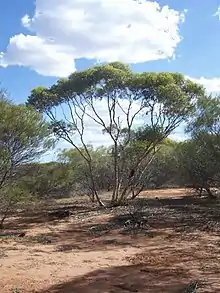Eucalyptus eudesmioides
Eucalyptus eudesmioides, commonly known as mallalie,[2] desert gum or mallabie[3] is a species of mallee that is endemic to Western Australia. It is a rounded, bushy mallee with smooth bark, egg-shaped to heart-shaped leaves arranged in opposite pairs, club-shaped flower buds arranged in groups of three, whitish flowers and cylindrical to barrel-shaped fruit.


| Mallalie | |
|---|---|
 | |
| Eucalyptus eudesmioides growing near Eurardy | |
| Scientific classification | |
| Kingdom: | Plantae |
| Clade: | Tracheophytes |
| Clade: | Angiosperms |
| Clade: | Eudicots |
| Clade: | Rosids |
| Order: | Myrtales |
| Family: | Myrtaceae |
| Genus: | Eucalyptus |
| Species: | E. eudesmioides |
| Binomial name | |
| Eucalyptus eudesmioides | |
Description
Eucalyptus eudesmioides is a mallee, sometimes a tree, that typically grows to 2–8 m (6 ft 7 in–26 ft 3 in) high, occasionally up to 10 m (33 ft) but usually less than 4 m (13 ft), and forms a lignotuber. It usually has smooth white to grey or brownish bark, sometimes with a rough, fibrous grey to brown bark near the base of the trunk. Young plants and coppice regrowth have sessile, egg-shaped to heart-shaped leaves arranged in opposite pairs and 25–75 mm (0.98–2.95 in) long, 10–35 mm (0.39–1.38 in) wide. Adult leaves are also arranged in opposite pairs and are lance-shaped to curved, 40–80 mm (1.6–3.1 in) long and 6–15 mm (0.24–0.59 in) wide on a petiole 3–10 mm (0.12–0.39 in) long. The flower buds are arranged in leaf axils in groups of three on a peduncle 3–13 mm (0.12–0.51 in) long, the individual buds on a pedicel 3–7 mm (0.12–0.28 in) long. Mature buds are club-shaped, 5–7 mm (0.20–0.28 in) long and 4–5 mm (0.16–0.20 in) wide with a rounded to flattened operculum, the stamens in bundles. Flowering occurs from February to May and the flowers are white. The fruit is a woody, cylindrical to barrel-shaped capsule 7–13 mm (0.28–0.51 in) long and 6–10 mm (0.24–0.39 in) wide with the valves at or near the level of the rim.[2][4][5][6]
Taxonomy and naming
Eucalyptus eudesmioides was first formally described in 1860 by the botanist Ferdinand von Mueller, initially as Eucalyptus eudesmoides in his book Fragmenta phytographiae Australiae.[7] The original name is an orthographical variant of E. eudesmioides.[8]
The specific epithet (eudesmioides) is a reference to the Eucalyptus subgenus Eudesmia.[5] The ending -oides is a Latin suffix meaning "likeness".[9]
Distribution and habitat
Mallalie occurs coastally and subcoastally from 100 kilometres (62 mi) north of Perth northwards to the Murchison River.[4] The range extends from Carnarvon in the Gascoyne south to Wongan Hills in the Wheatbelt region of Western Australia.[2] It grows in sandy soil on flat or low sloping areas in mallee woodland. It is one of the eucalypts identified in the Eurardy Reserve, a reserve that was established as a bush heritage property in 2011.[11]
Two subspecies, not yet formally described, are recognised by the Australian Plant Census:
Conservation status
This eucalypt is classified as "not threatened" by the Western Australian Government Department of Parks and Wildlife.[2]
See also
References
- "Eucalyptus eudesmioides". Australian Plant Census. Retrieved 2 July 2019.
- "Eucalyptus eudesmioides". FloraBase. Western Australian Government Department of Parks and Wildlife.
- Philip A. Clarke (2012). Australian plants as Aboriginal Tools. Rosenberg Publishing. ISBN 9781922013576.
- Chippendale, George M. (1973). Eucalypts of the Western Australian goldfields. Canberra: Australian Government Publishing Service for the Minister for Primary Industry. ISBN 0642000646.
- "Eucalyptus eudesmioides subsp. eudesmioides". Euclid: Centre for Australian National Biodiversity Research. Retrieved 4 June 2020.
- Chippendale, George M. "Eucalyptus eudesmioides". Australian Biological Resources Study, Department of the Environment and Energy, Canberra. Retrieved 2 July 2019.
- "Eucalyptus eudesmoides". APNI. Retrieved 2 July 2019.
- "Eucalyptus eudesmioides". APNI. Retrieved 2 July 2019.
- Brown, Roland Wilbur (1956). The Composition of Scientific Words. Washington, D.C.: Smithsonian Institution Press. p. 483.
- "Noongar names for plants". kippleonline.net. Archived from the original on 20 November 2016. Retrieved 2 July 2019.
- "Eurardy Reserve". Bush Heritage Australia. Archived from the original on 18 May 2011. Retrieved 2 July 2019.
- "Eucalyptus eudesmioides subsp. Pallida". Australian Plant Census. Retrieved 2 July 2019.
- "Eucalyptus eudesmioides subsp. selachiana". Australian Plant Census. Retrieved 2 July 2019.